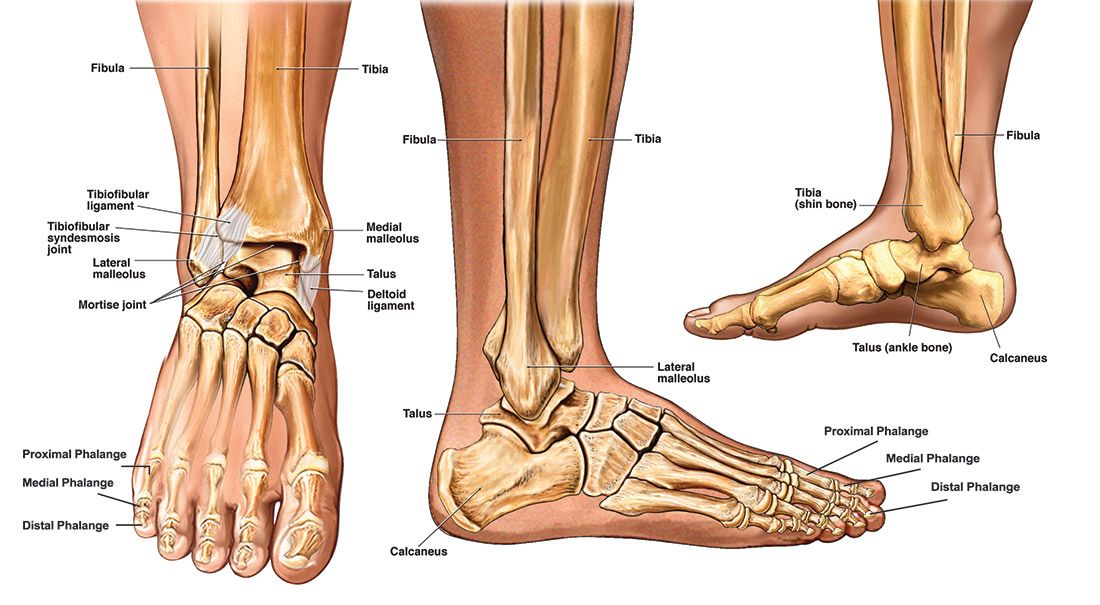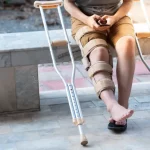Medically reviewed by Stuart Hershman, MD
Broken ankles may involve one or more of the three bones of the ankle joint—the tibia, fibula, and talus. There are different types of ankle fractures—lateral malleolus and bimalleolar fractures, for example—all of which are defined by exactly which parts of the ankle are affected.
The stability of the joint after an ankle fracture and the necessary treatment hinge on exactly where the break occurs.
This article reviews the bones that may be involved in an ankle break, the most common types of these injuries, how they impact the joint, and related symptoms.
Ankle Bones and Break Locations
A broken ankle is not one specific injury. The ankle is a complex joint that forms where the following bones come together. If you fracture your ankle, there may be a break in one or more of these.

- The tibia (shinbone): This is the larger, weight-bearing bone of the lower leg. Of the weight transferred through the leg, most of it is carried by the tibia. 1
- The fibula (calfbone): The fibula is the smaller bone on the outside of the leg. It helps support and stabilize your ankle.
- The talus: Both the tibia and the fibula wrap around the talus, a small ankle bone, to form the ankle joint.
The bony prominences at the ankle are called the medial malleolus (the end of the tibia) and the lateral malleolus (the end of the fibula). The ends of these bones form a cup shape that the talus bone sits within.
When a broken ankle occurs, the injury may be to the end of the tibia (the medial malleolus) or to the fibula (the lateral malleolus), or both. Talus fractures can also happen, but they are less common.
Determining how to proceed with treatment depends, in part, on the location of the injury.
Most Common Types of Ankle Fractures
While there are many types of ankle fractures, some are more common than others.
It’s important not only to know what bones are affected with each type of ankle fracture, but whether the break renders the ankle stable or unstable, as this effects treatment.
The stability of an ankle fracture describes how the talus moves in relation to the ends of the tibia and fibula:
- A stable ankle fracture is one in which a bone is broken, but the movement of the talus is unchanged.
- With an unstable broken ankle, the talus does not move in a normal manner. This means that the joint is not held in a symmetric position.
Lateral Malleolus Fractures
Bone(s) affected: Fibula
Fractures of the fibula alone are the most common type of ankle fracture.2
Many fibular fractures can be treated without surgery, but it is important to ensure the ankle joint remains stable. This means that even though there is a break in the bone, the ankle joint is still aligned normally.
If the ankle joint is unstable or the ligaments are damaged, then surgery is likely to be recommended.
Medial Malleolus Fractures
Bone(s) affected: Tibia
This fracture of the inner side of the ankle occurs to the bone on the end of the tibia (medial malleolus). An isolated medial malleolus fracture is much less common than an isolated lateral malleolus fracture.
In general, a displaced (out of position) medial malleolus fracture is treated with surgery.3
Bimalleolar Ankle Fractures
Bone(s) affected: Tibia and fibula
Bimalleolar ankle fractures occur when there is an injury to both the inner and outer side of the ankle.3
These injuries always result in an unstable ankle joint, and in most patients, surgery will be recommended. If the fracture heals in anything less than a perfect position, the ankle joint alignment will be affected and could lead to accelerated arthritis of the ankle.
Even with surgical treatment, ankle cartilage can be damaged at the time of the fracture leading to a higher chance of arthritis. Still, you should aim to do as much as possible to repair these fractures properly to keep the chance of long-term problems as low as possible.
Bimalleolar Equivalent Fracture
Bone(s) affected: Fibula
This injury is only a fracture of the fibula, but there is also a tear of the ligaments on the inner side of the ankle.3
This leads to instability of the ankle joint, just as if the inner side were fractured, and therefore can require surgery.
Trimalleolar Fracture
Bone(s) affected: Tibia and fibula
A trimalleolar ankle fracture is similar to a bimalleolar ankle fracture, but the bone in the back of the tibia is also fractured. The bone in the back of the tibia is called the posterior malleolus.
Posterior Malleolus Fracture
Bone(s) affected: Tibia
This is a rare injury in isolation. Fractures of the posterior malleolus are generally found in association with bimalleolar ankle fractures, in which case the injury is called a trimalleolar ankle fracture.
Maisonneuve Fracture
Bone(s) affected: Tibia and fibula
A Maisonneuve fracture is a less common injury, but needs to be considered as can easily be missed without a thorough examination.
In the Maisonneuve fracture, the bone is injured on the inner side of the ankle (the medial malleolus). While the lateral malleolus is intact, there is a fracture much higher up on the fibula bone, typically around the knee.
The force of this injury passes through the large ligament that connects the two leg bones, called the syndesmosis. Because of the damage to this supporting ligament, the ankle is unstable and surgery is most often necessary.
Talus Fracture
Bone(s) affected: Talus
Talus fractures usually occur on their own, without involvement of the tibia or fibula. Less than 1% of ankle fractures are talus fractures.4
This injury typically occurs during a major traumatic event, such as a car accident.5
Video: “Ankle Joint Recovery after Fracture”
EXERCISES FOR THE ANKLE JOINT. SET №6E IS AIMED AT STRENGTHENING OF THE MUSCLES AND IMPROVEMENT OF PROPRIOCEPTION AND STABILITY OF THE ANKLE AND ENTIRE LOWER LIMB. MID STAGE
For additional information about the recovery process after an ankle fracture, you can watch a video demonstrating exercises and rehabilitation recommendations.
Symptoms of a Broken Ankle
Common symptoms of an ankle fracture include:3
- Pain to touch
- Swelling
- Bruising
- Inability to walk on the leg
- Deformity around the ankle
There are clinical criteria used to differentiate ankle fractures from ankle sprains. These guidelines, called the Ottawa Rules, help determine if X-rays should be done in people who have ankle pain.6
Video: “Post-traumatic rehabilitation of gait disorders“
EXERCISES FOR POST-TRAUMATIC CORRECTION AND REHABILITATION OF GAIT. INITIAL STAGE – SET 1
For additional information about Post-traumatic rehabilitation of gait disorders you can watch a video demonstrating exercises and rehabilitation recommendations.
Treatment of a Broken Ankle
Once an ankle fracture is diagnosed, it is important to begin appropriate treatment. There are many treatments, both surgical and nonsurgical, and the right one depends on having the correct diagnosis.
Unstable ankle fractures are more likely to require invasive treatment.
Your surgeon can guide you on the best course of action in your case.
By Jonathan Cluett, MD
Dr. Cluett is board-certified in orthopedic surgery. He served as assistant team physician to Chivas USA (Major League Soccer) and the U.S. national soccer teams.
Summary
There are a number of different types of ankle breaks. These can occur in one or more of the three bones in your ankle: the tibia, the fibula, and the talus.
Ankle breaks can be stable or unstable. An unstable break affects the way the talus moves in relation to the tibia and fibula.
An ankle break may cause pain, swelling, bruising, and trouble walking. Treatment usually depends on the type of break.
FREQUENTLY ASKED QUESTIONS
When will I be able to walk after a broken ankle?
If you don’t need surgery, you might be able to walk on your own within six to eight weeks. If your fracture did require surgery, you may get a walking cast after two weeks; four to six weeks later, you may be able to apply some weight and be moved to a cast with a walker or crutches. It may then be a few more weeks before you can fully bear your weight and walk without any aids.
Learn More When Can I Start Running After an Ankle Fracture?
What exercises should I do once I’m out of an ankle cast?
Begin with range of motion exercises. A physical therapist can maneuver your ankle at first. Then you will begin exercises on your own such as pointing your toes and moving your foot in and out. These may be slightly painful as you get used to moving the joint again, but they should not cause severe or lasting pain.

Demo versions of GHRS sets of exercises for the Lower Limb Problems and Post-traumatic rehabilitation of gait disorders on YouTube
You can find more information about the Lower Limb Problems and Post-traumatic rehabilitation of gait disorders in our BLOG
Our website presents sets of exercises for rehabilitation of the ankle joint and gait disorders in the following four areas:
-
EXERCISES FOR THE ANKLE JOINT. SET №5 IS AIMED AT STRETCHING THE MUSCLES (IMPROVEMENT OF FLEXIBILITY OF THE MUSCULAR APPARATUS) AND INCREASE OF THE RANGE OF JOINT MOVEMENT
-
EXERCISES FOR THE ANKLE JOINT. SET №6D IS AIMED AT STRENGTHENING OF THE MUSCLES AND IMPROVEMENT OF PROPRIOCEPTION AND STABILITY OF THE ANKLE AND ENTIRE LOWER LIMB. INITIAL STAGE
-
EXERCISES FOR THE ANKLE JOINT. SET №6E IS AIMED AT STRENGTHENING OF THE MUSCLES AND IMPROVEMENT OF PROPRIOCEPTION AND STABILITY OF THE ANKLE AND ENTIRE LOWER LIMB. MID STAGE
-
EXERCISES FOR THE ANKLE JOINT. SET №6F IS AIMED AT STRENGTHENING OF THE MUSCLES AND IMPROVEMENT OF PROPRIOCEPTION AND STABILITY OF THE ANKLE AND ENTIRE LOWER LIMB. ADVANCED STAGE
-
EXERCISES FOR POST-TRAUMATIC CORRECTION AND REHABILITATION OF GAIT. INITIAL STAGE – SET 1
-
EXERCISES FOR POST-TRAUMATIC CORRECTION AND REHABILITATION OF GAIT. MIDDLE STAGE – SET 2
-
EXERCISES FOR POST-TRAUMATIC CORRECTION AND REHABILITATION OF GAIT. ADVANCED STAGE – SET 3
-
EXERCISES FOR POST-TRAUMATIC CORRECTION AND REHABILITATION OF GAIT. VERY ADVANCED STAGE – SET 4
Sources
https://www.verywellhealth.com/broken-ankle-2548484
- Johns Hopkins Medicine. Tibia and fibula fractures.
- Elsoe R, Ostgaard SE, Larsen P. Population-based epidemiology of 9767 ankle fractures. Foot Ankle Surg. 2018;24(1):34-39. doi:10.1016/j.fas.2016.11.002
- American Academy of Orthopaedic Surgeons. Ankle fractures (broken ankle).
- Buyukkuscu MO, Kulduk A, Alpay Y, Pehlivanoğlu G. Simultaneous fracture of the tibia shaft and talar body – a case report. Trauma Case Rep. 2019;21:100204. doi:10.1016/j.tcr.2019.100204
- American Academy of Orthopaedic Surgeons. Talus fractures.
- The Ottawa Rules. The Ottawa Ankle Rules.










